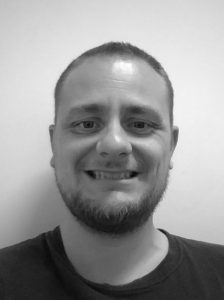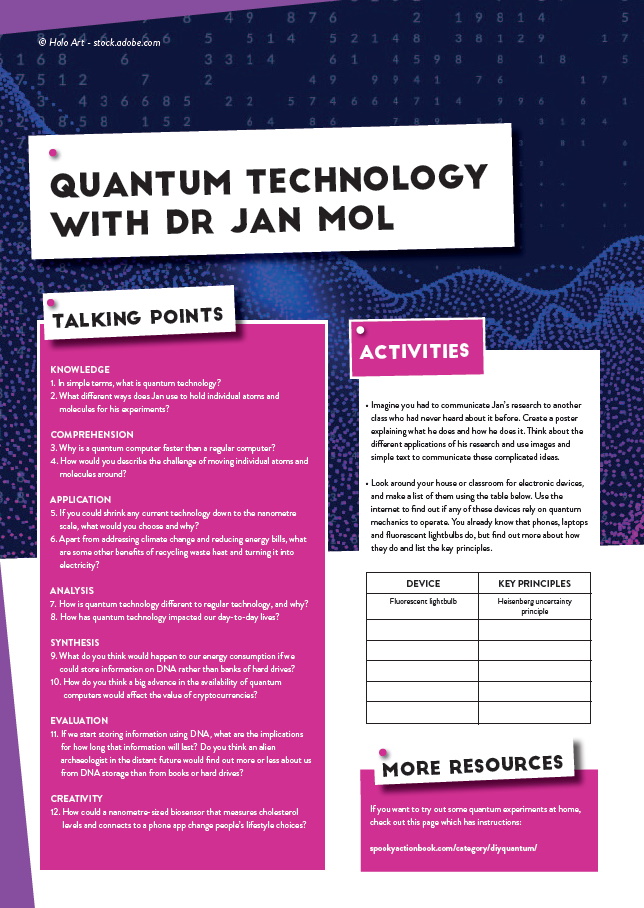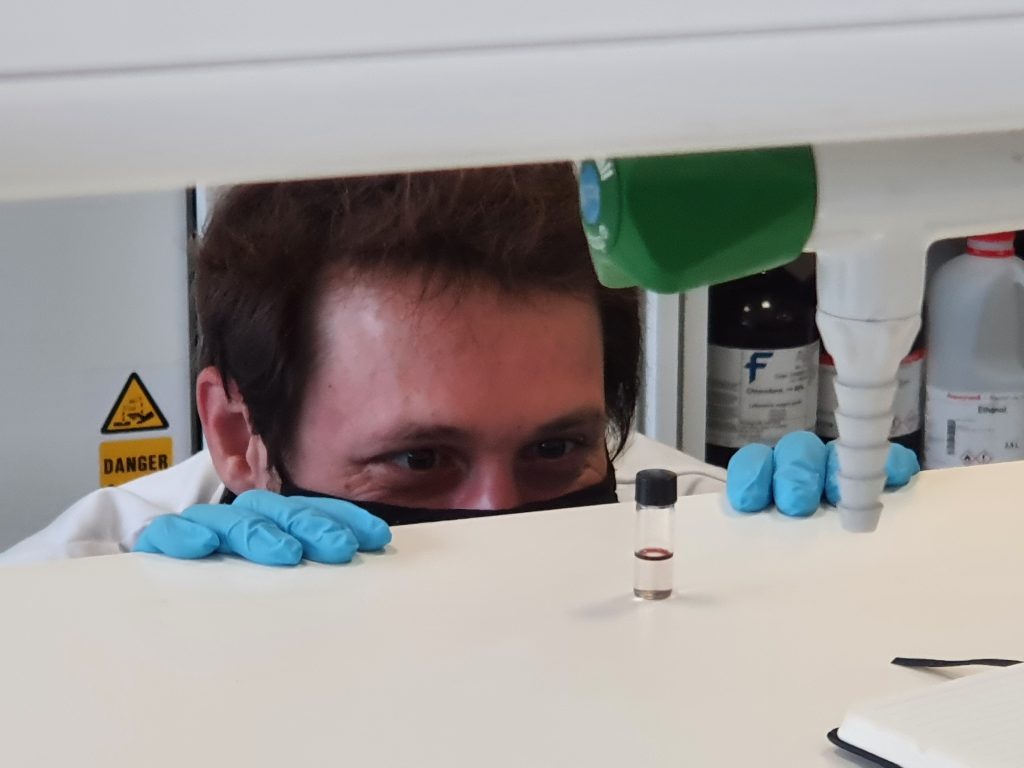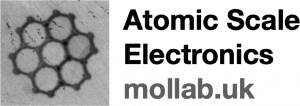How can we build quantum electronics from atoms and molecules?
Dr Jan Mol is an expert in quantum & nanoelectronics at the Queen Mary University of London, in the UK. He is trying to understand how electricity flows through individual atoms and molecules, with the aim of one day using them as electronic components
TALK LIKE A QUANTUM TECHNOLOGIST
ELECTRONIC COMPONENT – the basic building blocks of electronic circuits which control the flow of electrons. For example, resistors, diodes and transistors
NANOMETRE – a unit of length equivalent to one billionth of a metre
QUANTUM PHYSICS – a fundamental theory in physics that describes how things behave at the scale of atoms and subatomic particles
SUPERPOSITION – a principle in quantum physics that a system can be in two different states at the same time. For example, both on and off or both 1 and 0
ENTANGLEMENT – where a property of one particle is linked with that of another regardless of the distance between them
DNA – short for deoxyribonucleic acid. It is a molecule that contains the genetic code in a living thing. Can also be made in a laboratory and used to store information
Understanding the flow of electricity through individual atoms and molecules is key to building the smallest possible electronic components. These components could then be used to create tiny biosensors that could monitor your health in real-time, from inside your body, or super-fast quantum computers that can model complex systems like the Earth’s climate and financial markets. To give you an idea of the scale of these molecular components, think about this the next time you drink a glass of water: the glass contains ten million times more water molecules than there are grains of sand on all of Earth’s beaches and deserts combined. We normally experience the collective properties of all these water molecules as things like temperature and pressure. However, at the molecular and atomic scale, the classical physics we experience breaks down, and the weird world of quantum physics takes over. Even Albert Einstein, one of the key founders of quantum physics, described it as ‘spooky’!
Dr Jan Mol, of the Queen Mary University of London, has developed various methods to manipulate and hold individual atoms and molecules in place, to perform experiments on them using electricity. He is investigating some of these quantum properties that will allow the development of new forms of technology at the smallest scale possible. The first challenge is handling and manipulating something so small you cannot even see it using regular light.
HOW DO JAN AND HIS TEAM MOVE AN INDIVIDUAL ATOM OR MOLECULE?
Trying to move individual atoms and molecules around is a challenge because they are so incredibly small, and the tools used to move them are much larger! Jan says the process is like trying to pick up and move a single grain of rice using a digger. As if that was not enough of a challenge, Jan and his team want each molecule-sized device to work in exactly the same way, which is akin to picking up hundreds and thousands of grains of rice in exactly the same way every single time.
Various methods are used to build tiny structures that can hold individual atoms and molecules. Using the controlled breakdown of a material, so that the break is only a few nanometres wide, is one method. This is the same process as the breaking of a tungsten filament in an old lightbulb. Another way to do it is to take a very high-powered electron ‘microscope’ that can see individual atoms and use a beam of electrons or a very sharp needle to move the atoms and molecules around. Finally, there are chemical reactions that can create small metal spheres a few nanometres apart that can be used to hold molecules. Despite the challenges, there have been successful demonstrations of electronic devices that connect to an individual atom or molecule.
WHAT DO JAN’S EXPERIMENTS LOOK LIKE?
Now that the molecule has been carefully trapped in the structure, it is time to study its electronic properties. This is done in the same way as testing electrical components with a multi-meter. A voltage is applied at two points, called terminals, on the structure. An electric current begins to flow from one terminal, called the source electrode, to the other, called the drain electrode. Next, the current needs to flow through the molecule being tested, while a third electrode regulates the number of electrons that pass through the molecule. As the molecule is so small, only a few electrons can pass through it per second, and special instruments are required to measure the electrical current. Some of the experiments must be done at a very low temperature close to absolute zero (-273 degrees Celsius).
Reference
https://doi.org/10.33424/FUTURUM257
© Love Employee – stock.adobe.com
ELECTRONIC COMPONENT – the basic building blocks of electronic circuits which control the flow of electrons. For example, resistors, diodes and transistors
NANOMETRE – a unit of length equivalent to one billionth of a metre
QUANTUM PHYSICS – a fundamental theory in physics that describes how things behave at the scale of atoms and subatomic particles
SUPERPOSITION – a principle in quantum physics that a system can be in two different states at the same time. For example, both on and off or both 1 and 0
ENTANGLEMENT – where a property of one particle is linked with that of another regardless of the distance between them
DNA – short for deoxyribonucleic acid. It is a molecule that contains the genetic code in a living thing. Can also be made in a laboratory and used to store information
Understanding the flow of electricity through individual atoms and molecules is key to building the smallest possible electronic components. These components could then be used to create tiny biosensors that could monitor your health in real-time, from inside your body, or super-fast quantum computers that can model complex systems like the Earth’s climate and financial markets. To give you an idea of the scale of these molecular components, think about this the next time you drink a glass of water: the glass contains ten million times more water molecules than there are grains of sand on all of Earth’s beaches and deserts combined. We normally experience the collective properties of all these water molecules as things like temperature and pressure. However, at the molecular and atomic scale, the classical physics we experience breaks down, and the weird world of quantum physics takes over. Even Albert Einstein, one of the key founders of quantum physics, described it as ‘spooky’!
Dr Jan Mol, of the Queen Mary University of London, has developed various methods to manipulate and hold individual atoms and molecules in place, to perform experiments on them using electricity. He is investigating some of these quantum properties that will allow the development of new forms of technology at the smallest scale possible. The first challenge is handling and manipulating something so small you cannot even see it using regular light.
HOW DO JAN AND HIS TEAM MOVE AN INDIVIDUAL ATOM OR MOLECULE?
Trying to move individual atoms and molecules around is a challenge because they are so incredibly small, and the tools used to move them are much larger! Jan says the process is like trying to pick up and move a single grain of rice using a digger. As if that was not enough of a challenge, Jan and his team want each molecule-sized device to work in exactly the same way, which is akin to picking up hundreds and thousands of grains of rice in exactly the same way every single time.
Various methods are used to build tiny structures that can hold individual atoms and molecules. Using the controlled breakdown of a material, so that the break is only a few nanometres wide, is one method. This is the same process as the breaking of a tungsten filament in an old lightbulb. Another way to do it is to take a very high-powered electron ‘microscope’ that can see individual atoms and use a beam of electrons or a very sharp needle to move the atoms and molecules around. Finally, there are chemical reactions that can create small metal spheres a few nanometres apart that can be used to hold molecules. Despite the challenges, there have been successful demonstrations of electronic devices that connect to an individual atom or molecule.
WHAT DO JAN’S EXPERIMENTS LOOK LIKE?
Now that the molecule has been carefully trapped in the structure, it is time to study its electronic properties. This is done in the same way as testing electrical components with a multi-meter. A voltage is applied at two points, called terminals, on the structure. An electric current begins to flow from one terminal, called the source electrode, to the other, called the drain electrode. Next, the current needs to flow through the molecule being tested, while a third electrode regulates the number of electrons that pass through the molecule. As the molecule is so small, only a few electrons can pass through it per second, and special instruments are required to measure the electrical current. Some of the experiments must be done at a very low temperature close to absolute zero (-273 degrees Celsius).
WHERE COULD THIS RESEARCH LEAD?
There are a huge number of potential applications in chemistry, physics, electronics, medical equipment and artificial intelligence. Jan highlights three that could have a big impact on society in the future: quantum computing, data storage and energy harvesting.
Quantum computers harness the strange properties of quantum physics that occur at the atomic scale. These strange properties are lost as things get bigger, so you do not see them at the scale we live at where objects are made up of trillions of atoms. Jan says, “A trillion sounds like a lot, but actually it isn’t. At our scale, we’re looking at trillion trillions (10^24).” If you can control these quantum properties in a computer, you can perform certain tasks exponentially faster than a regular computer which is limited by the laws of classical physics. A regular computer uses bits to store information, and these can be either a 1 or a 0, whereas a quantum computer uses qubits, which can represent both a 1 and a 0 simultaneously. This means that eight bits in a regular computer can represent any number between 0 and 255, whereas eight qubits could represent all the numbers from 0 to 255 simultaneously. This is where the exponential difference in speed comes from.
The inspiration for data storage comes from nature, specifically DNA. A single molecule of your DNA contains about a gigabyte of information which stores all your genetic information. Jan and his team are trying to store data and read it using molecules in the same way your body does. Using DNA to store data would be incredibly efficient compared to current methods which are bulky, inefficient and use lots of energy, most of which ends up as waste heat.
In fact, most human activity generates a lot of waste heat. Around 70% of all the energy we consume globally is lost as waste heat, so there is huge potential if you can find a use for it. To feel this waste heat in action, just put your hand under your laptop or phone. Harvesting waste heat energy and turning it into electricity by using nanostructured materials could increase the efficiency of our energy consumption, which in turn has big implications in the fight against climate change, as well as savings on energy bills. Some of the waste heat coming off the back of your phone might one day be used to charge the battery.
WHAT ARE THE SUCCESSES SO FAR?
Jan has managed to study a single phosphorous atom, which is a potential key building block of quantum computers. He used a special microscope to investigate the quantum properties of the atom. He has also studied a molecule called fullerene (which looks a bit like a football made of 60 carbon atoms) which has the potential to convert heat into electricity. Finally, Jan has worked on a method to scan and read DNA molecules by passing them through a very small hole called a nanopore, just a few nanometres across and only slightly bigger than the molecule itself. This is done in a salt solution which is full of ions which flow across the nanopore when a voltage is applied. As the DNA molecule moves through the nanopore, it blocks and changes this flow of ions, which can be measured and provides a way to read the DNA molecule.
WHAT’S NEXT?
The future work in molecular electronics will focus on improving the reliability of the connections to the individual atoms and molecules. From there, these technologies are going to require lots more creative scientists like Jan to develop new and exciting ways to build molecular electronics that will improve our lives in the future.
 DR JAN MOL
DR JAN MOL
UKRI Future Leaders Fellow, Materials Research Institute Academic Fellow, Reader in Quantum & Nanoelectronics, Queen Mary University of London, UK
FIELD OF RESEARCH: Quantum and Nanoelectronics
RESEARCH PROJECT: Developing ways to use individual atoms and molecules as electronic components that can be used for highly efficient data storage, quantum computing and generating electricity form waste heat
FUNDER: UK Research and Innovation
This work is/was supported by the UKRI Future Leaders Fellowship, under award number MR/S032541/1, with in-kind support from the Royal Academy of Engineering
 DR JAN MOL
DR JAN MOL
UKRI Future Leaders Fellow, Materials Research Institute Academic Fellow, Reader in Quantum & Nanoelectronics, Queen Mary University of London, UK
FIELD OF RESEARCH: Quantum and Nanoelectronics
RESEARCH PROJECT: Developing ways to use individual atoms and molecules as electronic components that can be used for highly efficient data storage, quantum computing and generating electricity form waste heat
FUNDER: UK Research and Innovation (UKRI Future Leaders Fellowship, Grant No. MR/S032541/1.)
This work is/was supported by the UKRI Future Leaders Fellowship, under award number MR/S032541/1, with in-kind support from the Royal Academy of Engineering
ABOUT QUANTUM TECHNOLOGY
Quantum mechanics began as a theory over 100 years ago and is used in everyday technologies. Lasers and fluorescent lights both rely on something called spontaneous emission which is a direct physical manifestation of the Heisenberg uncertainty principle. This is one of the most famous principles in quantum physics which, in simple terms, means that knowing the location of a particle prevents you from knowing its speed and direction.
Another common piece of technology that uses quantum physics is a transistor. Jan explains, “Transistors that are in your laptop or smartphone rely on quantum mechanics because they are made of semiconductors – crystalline material where there is an energy gap between the electrons that bind the atoms in the crystal and electrons that can move around freely.” Quantum physics is a huge and complicated subject, but there are many popular science books that explain the concepts in simple terms if you want to learn more.
WHAT WILL THE NEXT GENERATION OF QUANTUM TECHNOLOGISTS WORK ON?
In recent years, scientists have taken advantage of other strange quirks of quantum mechanics such as superposition, where quantum systems can exist in several states at the same time, and entanglement, where two particles are linked even when they are miles apart. Entanglement is what Einstein called, “spooky action at a distance”. The challenge is transferring these principles into real technology in the lab – future quantum technologists will develop super precise engineering at atomic and molecular scales to develop quantum computers and other technologies. These computers will also require an entirely new type of programming that makes use of superposition and entanglement, so future quantum technologists will need to be creative. Are you up to the challenge?
EXPLORE CAREERS IN QUANTUM TECHNOLOGY
• Jan recommends exploring some online resources to see what is involved, including talks from Michelle Simmons at the University of New South Wales and the Oxford Nanopore Technologies website which has videos on DNA sequencing using nanopores.
• There are also lots of video resources on quantum technology on the International Artificial Intelligence and Quantum Technology (AIQT) Foundation website.
• Average annual salaries for a research scientist in academia (after completing a PhD) in the UK are between £25,000 and £35,000, which rises with new responsibilities. University professors and principal investigators can earn more than £50,000 per year.
PATHWAY FROM SCHOOL TO QUANTUM TECHNOLOGY
• Jan recommends studying maths, physics and chemistry at school, college and university.
• You will also need to complete postgraduate studies, such as for a master’s and PhD, in a relevant topic.
• More general guidance on becoming a physicist can be found on the government’s careers website.
HOW DID JAN BECOME A QUANTUM TECHNOLOGIST?
WHAT WERE YOUR INTERESTS WHEN YOU WERE GROWING UP?
I have always been interested in figuring out how stuff works. Back in the 90s, computers weren’t that shiny or smart, but it was a lot of fun taking them apart and reassembling them again (or breaking them and getting them to work again).
WHO OR WHAT INSPIRED YOU TO BECOME A SCIENTIST?
I don’t think there was a specific moment at which I decided to become a scientist, I just naturally progressed in that direction. There are of course lots of interesting characters in physics, people like Richard Feynman, but I think I only found out about them when I was already a physicist myself.
WHAT ATTRIBUTES HAVE MADE YOU SUCCESSFUL AS A SCIENTIST?
Curiosity.
HOW DO YOU OVERCOME OBSTACLES/SWITCH OFF FROM YOUR WORK?
I enjoy long distance running. Running a marathon is an all-consuming activity and allows no time to worry about anything else.
WHAT ARE YOUR PROUDEST CAREER ACHIEVEMENTS SO FAR?
Teaching our two-year-old daughter arithmetic – it’s work in progress!
01 This stuff is not easy to get your head around, so only do it if you really enjoy it.
02 Be curious!
Do you have a question for Jan?
Write it in the comments box below and Jan will get back to you. (Remember, researchers are very busy people, so you may have to wait a few days.)








